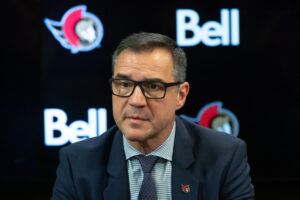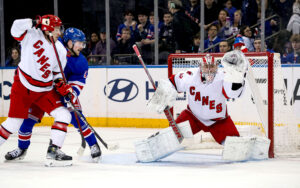College hockey recruiting will be undergoing some changes after the NCAA adjusted its rules in April. These rules adjustments were made to slow down the tide of early recruiting done across many sports and are slated to go in effect with the 2018-19 season.
There have been stories in sports like football, basketball and hockey that have prospects committing to colleges at early ages. It seems the race to get these talented youths was starting to happen earlier with each passing year.
Some Background
Players usually go on two paths to make pro hockey. A prospect that plays for a CHL team, also known as major junior, will immediately be ineligible to play college hockey. The NCAA considers leagues like the OHL, QMJHL and WHL as professional leagues because of they allow players to play after they sign NHL entry-level contracts.
Tier I league’s like the USHL and the Tier II NAHL allowed younger players to keep their NCAA eligibility. High school athletes often don’t go straight to college as they spend time in these leagues to hone their skills. Canadian Junior A leagues like the BCHL, AJHL, and OJHL also allow players to keep NCAA hockey.
Websites like College Hockey Inc. have a great FAQ section that explains all the information in detail.
College Hockey Recruiting Changes
The main change was to limit the time visits can happen. These visits can start on September 1st of the prospect’s junior year in high school. The two different varieties of visits are official and unofficial.
Schools pay for the two-day official visits and an athlete can only make five of these. However, these visits are regulated to one per school. Prospects are allowed an unlimited number of unofficial visits as long as they pay for them.
The changes were made to let students focus on academics instead of on sports. Lacrosse and softball also had additional legislation for their respective sports.
Backers of the legislation are hoping that it will slow the recruiting process and give institutions a chance to know more about a student’s academic situation.
“These changes will improve the recruiting experience for prospective student-athletes and coaches and lead to better decision-making,” said Blake James, Council chair and Miami (Florida) director of athletics. “Ultimately, a better recruiting process will improve the college experience for Division I student-athletes.”
The NCAA is hoping to make September 1st a banner day in recruiting for all sports.
How it Could Backfire
There could be one problem with these new regulations and that there could be a run on eighth-graders declaring their college intentions in an end-run around the rules.
Schools were eager to try and get in under the wire before the rule changes went down. Minnesota-based recruit Nick Pierre committing to the University of Wisconsin was an example of trying to get in before the changes. The 14-year-old committed to Coach Tony Granato’s team.
Pierre’s scheduled unofficial visit on May 12 had to move it up to April 22 because of the rules meeting. The young forward gave the Badgers an oral commitment. He was the first player born in 2004 to give the team a commitment.
There are big concerns that colleges could lose out on players to the major junior ranks. Players won’t have much of a chance on weighing their options with the new deadline. Granato even told Wisconsin’s State Journal of Madison that it’s ”putting the kid in a bad position to have to make that decision.”
What It Means For The Future
There are positives and negatives to the rule changes. I understand the NCAA wants to make sure the players get a proper education but the lure of major junior is strong and may take players away from the college ranks.
Competition between the CHL and NCAA for prospects has always been fierce. College hockey has always been behind major junior when it comes to getting these players. The new rules may make things more difficult. CHL Drafts happen when players are 15 and 16 years old. With the new rules, there will be many cases where the CHL will get the first opportunity to convince players to commit before they can even hear from college coaches.
College hockey is an underrated route to the pros because players are still testing themselves against some of the best players in their age group. One thing is for sure, the new college hockey recruiting rules will take time for everyone to understand.






